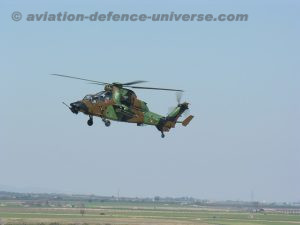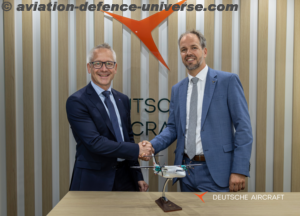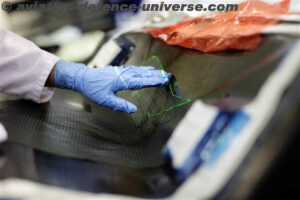- Indra’s next-generation mission and electronic defence systems will strengthen platform survivability, preparing it to face the more diverse and sophisticated threats
- Indra is overcoming the new technology challenges to ensure the superiority of the latest generation aerial platforms
Madrid, June 1st, 2022.- Indra, a leading global technology engineering company for the aerospace, defence and mobility sectors, has been awarded several contracts worth 90 million euros with OCCAR (Organisation for joint Armament Cooperation) to equip the Spanish Army’s 18 Tiger MKIII helicopters with next-generation mission and electronic defence systems, which will allow the Army to operate under unpredictable and sophisticated threat scenarios expected for the future.

The current version of the Spanish Tiger helicopter has proven its operational capability in difficult theaters such as Afghanistan. Now, with its evolution to the MKIII version ordered by OCCAR in March 2022, it will be prepared to face new threats that incorporate advance guidance systems, much more sophisticated, sensitive and difficult-to-detect that the enemy will use to prevent it from accessing areas of interest, thus jeopardizing its security.
To guarantee its superiority and dominance in every operation, Indra will equip the Spanish MKIII Tiger with state-of-the-art digital solutions for self-protection electronic warfare systems (EWS) and the most modern tactical mission system (SPC2) available, which will begin flying in 2030. Indra will also provide the whole MKIII fleet, including Spain and France, with the Identification Friend-or-Foe system (IFF) for a total of 82 helicopters.
Indra’s CEO, Ignacio Mataix, highlights that “once again, Indra demonstrates an extraordinary capacity to develop next-generation systems, with 100% Spanish technology, thanks to its extensive operational experience, the commitment to the development of critical systems, and a strong spirit of collaboration with clients, companies, research centers and universities across the continent, which are key to its contributio n to the definitive consolidation of European Defense”.
The self-protection suite (EWS) that Indra will implement on the Tiger MKIII will feature a sophisticated radar warning receiver system, the ALR-400FD Full Digital, which offers direct spectrum digitization with great signal processing capability in order to detect surveillance systems and targeting sensors before they lock onto the platform. This element also plays a critical role as it incorporates the EW Manager function, responsible for managing and integrating all the aircraft’s self-protection elements and activating countermeasures to automatically neutralize any ground-to-air or air-to-air attack. The new version of the Tiger will thus share technology with the aircraft fleet in more than 15 defence armed forces for which Indra is already implementing this type of systems to guarantee their self-protection. These include among others, the NH-90, AS-532, CH-47F and CH-53 helicopters, the A400M and C-295 transport aircraft, Gulfstream G-505 mission aircraft as well as the F-18 fighter jet.
Regarding the IFF Identification System, Indra will integrate its solution in the Spanish and French Tiger MKIIII fleet. This system will allow both the identification of the platform itself to third parties and the interrogation of other aircraft in order to classify them as friend or foe, thanks to the CIT-25A combined interrogator/transponder system. The equipment is complemented by elements such as the remote control box, the control matrix and a Mode 5 crypto-computer, a clear modernization in comparison to current systems of this type. The integration also includes US DoD AIMS certification in order to be able to operate in all types of international scenarios, a prerequisite for IFFs operating with the new Mode 5 Identification within NATO.
Finally, Indra’s tactical mission system (SPC2) will enable interoperability of the helicopter with the command and control to provide Spanish Army commanders and pilots with a digitalized view of the battlefield in real time in the various theaters of operations. The helicopter will have the capability to relay and synchronize tactical information from different platforms through various radios and data links, correlating, fusing, and routing this data with the tactical information collected by the helicopter’s various sensors. The ultimate goal is to facilitate the pilots’ decision-making by reducing uncertainty and ensuring a perfect execution of the operation, with total coordination that ensures agility and precision and increases the chances of success.
Defence Leader in Europe
Indra is one of the leading global engineering technology companies serving the Defence industry and a leader in the industry’s digitalization. Its state-of-the-art solutions for Land, Sea and Air, Space and Cyberspace range from operations with end-to-end defence systems and systems on board the most advanced platforms to training with cutting-edge simulation systems. As an expert in radar, electronic defence, command and control and communication technologies, Indra incorporates artificial intelligence, big data, virtual reality and combat clouds in its cutting-edge critical systems. The company is the Spanish industrial coordinator of the FCAS, the largest and most advanced defence program in Europe. It is the Spanish company that coordinates the most projects in the European defence sector, and participates in a large number of international projects, such as the Eurofighter aircraft and the A400M. The company exports its radars to five continents and is the principal supplier to NATO.
The company also stands out as one of the most advanced companies in Europe in terms of electronic defence and is the main contributor to the continued superiority of EU countries in the radio spectrum, which is essential in any land, naval or air operation. In the specific field of aerial platforms, it has consolidated one of the most powerful self-protection suites in existence. It includes everything required for platform survivability, from suite management and integration to radar warning, missile warning and laser warning subsystems, and countermeasures such as chaff and flare dispensers and directed infrared countermeasures (DIRCM). The company is also leading the European CROWN project, which is pushing the limits of technology to ensure that European fighters of the future maintain their tactical advantage in this area.


























































































































